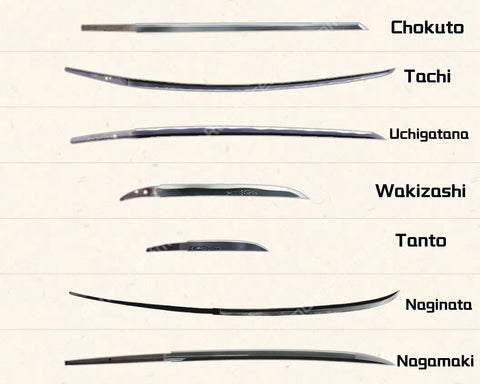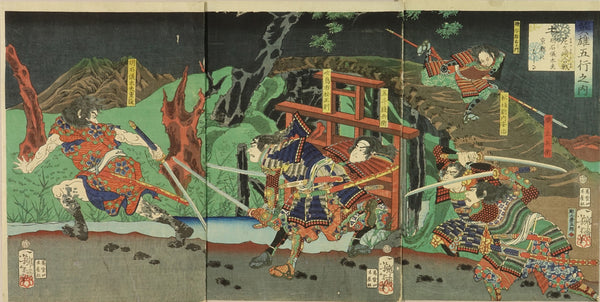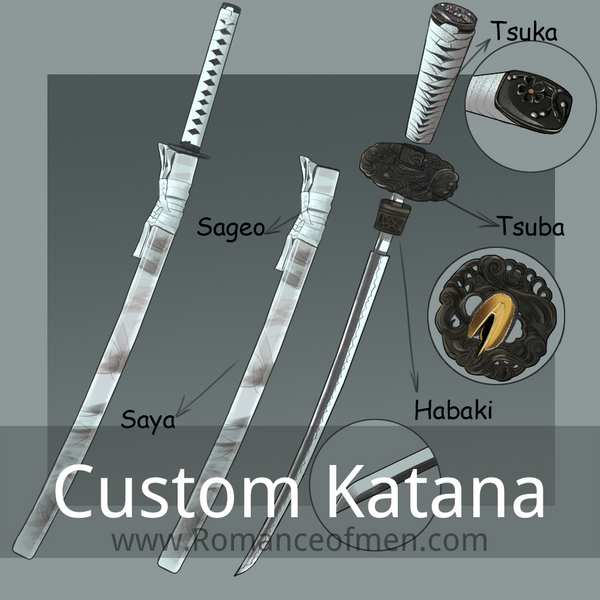Katana 101 - Everything you should know about this legendary weapon
The katana, also known as samurai sword, is a curved, single edged long sword. It’s a famous Japanese weapon and plays a huge role in Japanese culture, Katana represent the soul of a samurai. Compare with other famous weapons around the world, Katana has very unique character, It’s a deadly weapon and it’s also an aesthetic piece of art. It’s many collector’s dream to have an authentic antique Katana.
Today, Katana can be found in many movies, anime and TV shows, Katana makes any cool things even cooler, it’s the best choice of weapon for a bride in Bruce Lee’ yellow suit (from the movie Kill Bill), or for a team of talented young man hunting for demons (from the anime Demon Slayer). Everyone wants a Katana, but how much do you really know about it? In this article, we will walk you thought everything about Katana, you will learn the history, the evolution, the buying guide, all the components, everything you need you know to up your Katana game.

History of Katana
In Japanese, “Kata” means “one side”, “Na” means “blade”, together, “katana” means “single edged sword”, very straight forward and easy to remember right? But sword in Japanese history isn’t always like the curved katana we know today.
Before Heian Period (about 794-1192), Japan was heavily influenced by China (Tang Dynasty) in many aspects, all the way from writing language to food, swords are no exception. During this period, Japanese swords are just like Chinese swords, they are straight blade, double edge. In late Heian period, the samurai class was formed, and a legendary blade smith make a small, but significant change to the swords,
Amakuni was a famous swordsmith in Yamato province. When watching the emperor’s warriors return from battlefield, he noticed that many swords were broken, because straight blade swords get stuck and break easily from slashing moves. Amakuni decided to create swords that suits better the way soldiers flight and won’t break easily. He took a vow, stay in the forge for 7 days and nights, using the best iron sand, preyed to the shinto gods, finally he makes the first curved swords, which eventually evolved into the Katana we know today.
Although this is a legend story, but it makes a lot of sense because weapons should be adapted to the way of flighting. The ending of this legend is that Amakuni become immortal because his invention took many blood. We don’t even know if that’s a punishment or reward.
The evolution of Katana after Heian period is a long history, and many changes are on small details. We will skip this part in this article, to summary it, over the years, Katana became less a weapon, at least less a primary weapon in the battlefield (spears & bows are), and more of an art object. The effort required to make a “perfect” katana is tremendous, it’s very normally to make months to make a tiny polishing detail right. It’s kinda irony if we define Katana as a weapon, weapons should be consumables, instead of delicate.
In 1876, all Japanese civilians are not allowed to carry swords out in public. This marks the era of samurai coming to it’s end, Katana gradually lost its glory in battlefield, but soon find a position in the world of pop culture.

Modern Katana
The traditional katana sword smithing is a very intricate, time consuming and labor intensive process. Start from the raw material, in ancient times, the best kind of katana should “tamahagane”, literally means “precious steel”, it’s made of iron sand only be found in the Shimane region in Japan. The sands were heated to 1200 °C, and mixed with charcoal to increase the carbon of the steel, makes the steel harder.
Making the steel alone takes about 3 days, and the final result isn’t always stable. Experience swordsmith will assess the quality of the tamahagane by checking the color, bright silver is the good color for sword material. As you can see, the whole ancient swordsmith process rely heavily on individual skill and experience, things you can’t measure or quantify. The final result could be superior in terms of craftsmanship but the cost is very high and not suitable for mass production.

In late 19 century, as Japan start prepare for their invasion war, Japanese military requires all offices must wear a sword, demand of katana swords was increasing rapidly. The concept of mass production was introduced. To supply large amount of swords in a short time, modern metal was used instead of Tamahagane, using power hammer, modern heat treatment technology, even beginner blade smith can make a functional katana without much training. Mass production significantly cut down the cost and time, katana made in these period using modern production, are called “Gunto” , most of them were confiscated after world war 2, if you bump into an antique katana in pawn store, it’s likely a “Gunto” .
Today, majority of the katana for practice kenjutsu or personal use, collection, are made of modern steel and using modern mass production method. Katana become more accessible to everybody, you can custom your own Katana at a very reasonable price nowadays. You might wonder what’s better, the traditional or modern katana. The fact is, aside from cost saving, modern steel outperforms “tamahagane” in terms of hardness, edge retention and flexibility. Katana making strictly follows the traditional method will easily cost you more than 10,000 USD, it’s more for collection instead of actual use. If you own one, will you use it for Tameshigiri?

Types of Katana (Nihonto)

Let’s get one common misconception right. Technically, all Japanese swords should be called Nihontō, and Katana is one type of Nihontō. There are some famous types of Nihontō you might have already heard of: Tachi, Katana, Wakizashi, Tanto etc. In this section, we will walk you thought all sort of Nihontō and their distinctions.
Let’s begin with size and shape, these are the most noticeable characters of a sword:
Ken - 剣
Remember we mentioned earlier that there were straight samurai swords? Yes they are called “Ken”, or “Tsurugi”, it’s double edge straight swords, just like the Chinese sword “Jian”, it was once the only kind of sword in Japanese history, but it was replaced by the curved blade completely after 10th century.

Chokutō - 直刀
Similar to Ken, its a straight, but single edge sword. It’s also origin from China, Tang Dynasty. The design is just like Chinese Dao, or precisely, Dao from Tang Dynasty, called TangDao (唐刀). Together with Ken, after 10th century Chukuto no longer used as weapon, only in ceremony.
Straight blade swords are also the choice of weapon for the ninjas, called "Ninjatō" 忍者刀

Tachi - 太刀
Basically it’s the early form of Katana, it’s a longer Japanese sword, more curved than the Katana we know. Before 15th century, Tachi is the mainstream choice of weapon for the samurai class. Tachi marks the beginning of an era for Japanese sword (Nihonto), it was once heavily impacted by Chinese weapons, but now Japanese creates it’s own unique & incredible design, even begin to export Tachi back to China as treasure.

Small version of Tachi is called “Kodachi” 小太刀
Larger Version of Tachi is called “Ōdachi “ 大太刀 / 野太刀
A sword with handle as long as the blade is called “Nagamaki” 長巻
Uchigatana - Katana - 刀 / 打刀
Katana, official term is Uchigatana, is the samurai sword we know, it’s a curved blade about 60-90cm long. Needless to say, it’s possible the most famous weapon in the world, and it’s a huge symbol of Japanese culture. After 15th century, Katana is the major weapon, and carry high artistic and collection value.
Wakizashi - 脇差
During Edo period, all samurais are required to wear 2 Katana, a standard one, and a shorter one, for the shorter one many would choose Wakizashi. Wakizashi is basically a shorter version of Katana, the blade is about 30-60 cm long, and many fitting are the same size. Wakizashi serves as a spare Katana and able to flight in narrow space. Learn more about the wakizashi sword in this guide.

Tanto - 短刀
Tanto is essentially a mini size Katana. You might have heard about the ritual suicide form “Seppuku”, that a samurai commit suicide by cut his belly by himself. The choice of weapon here is Tanto. Learn more about the tanto sword in this guide.

Sword even smaller than Tanto is called “Kogatana”, 小刀, basically the size of a utility knife, at the end of day, you don’t really want to use katana to cut an apple right?
A pair of long and short swords are called “Daishō” , Literally means “big and small” Many will buy Katana, wakizashi and tanto as a full set.
While the term Nihontō means Japanese Swords, it actually covers other pole weapons as well. Such Yari (槍) Spear, Naginata (薙刀), a weapon similar to GuanDao, a long pole with Katana on top.
There are other terms for Nihontō if we classify swords by their period, their place of origin and sword school, we cover more details in the article here.
Buying a Katana
Now that we are no longer a layman in the world of Japanese sword, it’s time to buy our first Katana, and the first thing we should consider is the purpose of the Katana. If you are buying for decoration and collection, or if you are buying for actual kenjutsu practice.
For decoration and collection:

Katana is more than just a lethal weapon, the aesthetic appearance and legendary myths behind it makes it a great addition to your home or sword collection. Katana is the soul of samurai and represent honor and authority, having one in your house is a great way to show your personality.
Clay tempered blade is great for decoration swords, it’s a traditional heat processing method, using a special clay to cover only the spine of the blade during the quenching process, so that the edge of the blade will cool down fast and become harder, the spine will cool down slower and remain more flexible. The result is a perfect blade for battle, it will cut and it won’t break easily. But for decoration purpose, what we want is only the byproduct of the clay tempered process, the hamon line.
Hamon line is basically the line separate the part with clay and the part without, after a blade completed the quenching process, blade smith will use special whetstone to polish it and bring out the hamon line. In the very beginning hamon line is a straight line, over time there are grass shape, wave shape, mountain shape etc. The blade is a canva in the hand of blade smiths, they use fire and steel to paint their creative designs.
We also recommend Pattern steel, also known as Damascus steel for decoration swords. It has fascinating patterns in the blade, the steel is combination of different types of carbon steel, and folded thousands of times.
Aside from the blade itself, basically all parts of a katana has its own art value we can appreciate. The Saya (scabbard) and Tsuba (hand guard) will obviously draw a lot of attention, but as small as a pin cover (menuki) in the handle (Tsuka) has dedicated designs, like Dragons, Phoenix, flowers etc. Don’t miss the details when appreciating your katana!
For actual use and practice:
First and the most important thing, if you are new to swords, we highly recommend using a dull edge katana and learn the basic moves. Only use a sharp on when you are skilled enough for tameshigiri.
When we plan to use Katana frequently, other than the aesthetic parts, we should also consider things like the balance of the blade, the handle wrapping tightness, the edge retention, and the most critical part, the blade material, especially for actual cutting.
Our recommendation is spring steel, it’s a modern steel that is hard enough, and still very flexible, it will bounce back even you bent it to 70-90 degree. That means it can tackle basically all sort of material for tameshigiri, or even harder objects if you like, without worry about breaking the sword can cause damage to you or others.
Clay tempered T10 Steel is also a great choice, compare to Spring steel, T10 is much harder, that means a better edge retention, and depends on the user’s skill, a better cutting experience.
Remember to maintain your katana properly, especially if you are using it for cutting frequently
Price range and shipping
At about 100 USD, you can get a decent entry level from romanceofmen.com. We also offer higher level swords at a competitive price. If you can’t find the right katana from our designs, you can always build your custom katana from us.
Katana, or any other swords, knives, might be considered weapons in the eye of customs. Having a katana stuck or confiscated at the customs is a pain. While we can’t guarantee anything related to customs because we can’t possibly know all the laws from different countries, we been in this business for years and here are the countries we successfully shipped to without any problem:
We love shipping Katana to: Australia / Canada / Denmark / France / Finland / Malaysia / Mexico / Germany / Netherlands / Norway / New Zealand / Sweden / Switzerland United States /
Always check your local laws about buying and owning a Katana, if you have any doubts, don’t hesitate to contact us.
Parts of Katana explained

There are over 30 parts on a Katana, and each one has its own story to tell, we have another article dedicated to explain more each parts, about their history, making, material, aesthetic value etc. But in this article, we will introduce only the major parts of a Katana:
The Blade:
The blade is the most important part of the sword. The traditional Japanese katana is believed to have been forged from sacred steel called Tamahagane by sword smiths, while modern katanas are more commonly made from carbon steel, manganese steel or T10 Steel etc, which makes the final product more affordable to everyone, and easier to control overall quality.
The Saya:
The saya is the scabbard that holds the katana blade. The saya is typically made with a wood core and wrapped in a layer of lacquer, often decorated with intricate designs and brightly colored silk cords. Many saya are decorated with engravings or carvings. Different types of wood have different colors and patterns that affect the appearance of the blade when it is sheathed.
The Tsuba:
Tsuba is the hand guard on the handle, it was just a plain metal plate to protect the hand in the beginning, but over time it has more of an ornamental piece. Craftsmen make tons of different themes, naturalistic and religious themes are most common, normally things that symbols good luck, courage, honor etc.
The Habaki:
Habaki is the metal collar between the blade and the handle of a Katana, it keeps the blade firmly inside the saya. Many Habaki comes with engraving designs, like name of the samurai clan.
Personalize your own katana
In the ancient Japan, it will take years for a samurai to work with a swordsmith to build the katana just for him. Nowadays the process is much easier, we offer a custom katana service so anyone can order a katana that’s made entirely to their preference.
Start from the blade, you can choose Carbon steel, Manganese Steel, Spring Steel, Pattern Steel and T10 Steel. If you are buying the sword for decoration, Pattern steel and T10 Steel is highly recommended, you can appreciate the fascinating and unique pattern on the blade. If you are new to swords and going for try some actual cutting, Spring steel is a great choice, it has high flexibility and won’t easily break.
We have over 100 themes for saya and tsuba, you can certainly find the perfect match for your taste, and make a truly unique sword just for you.






















